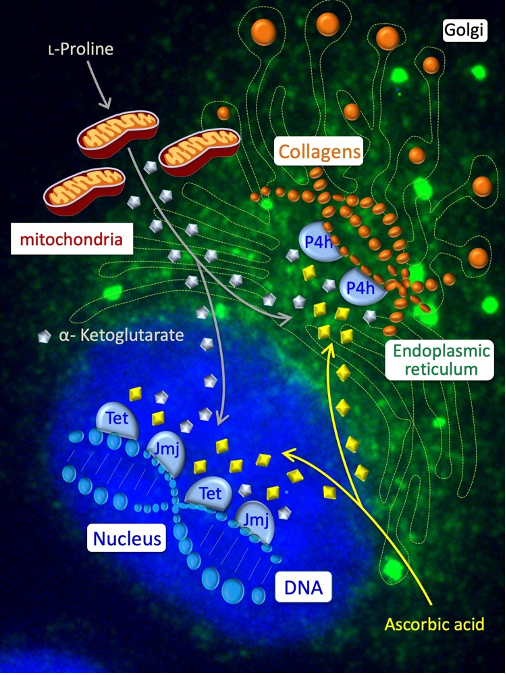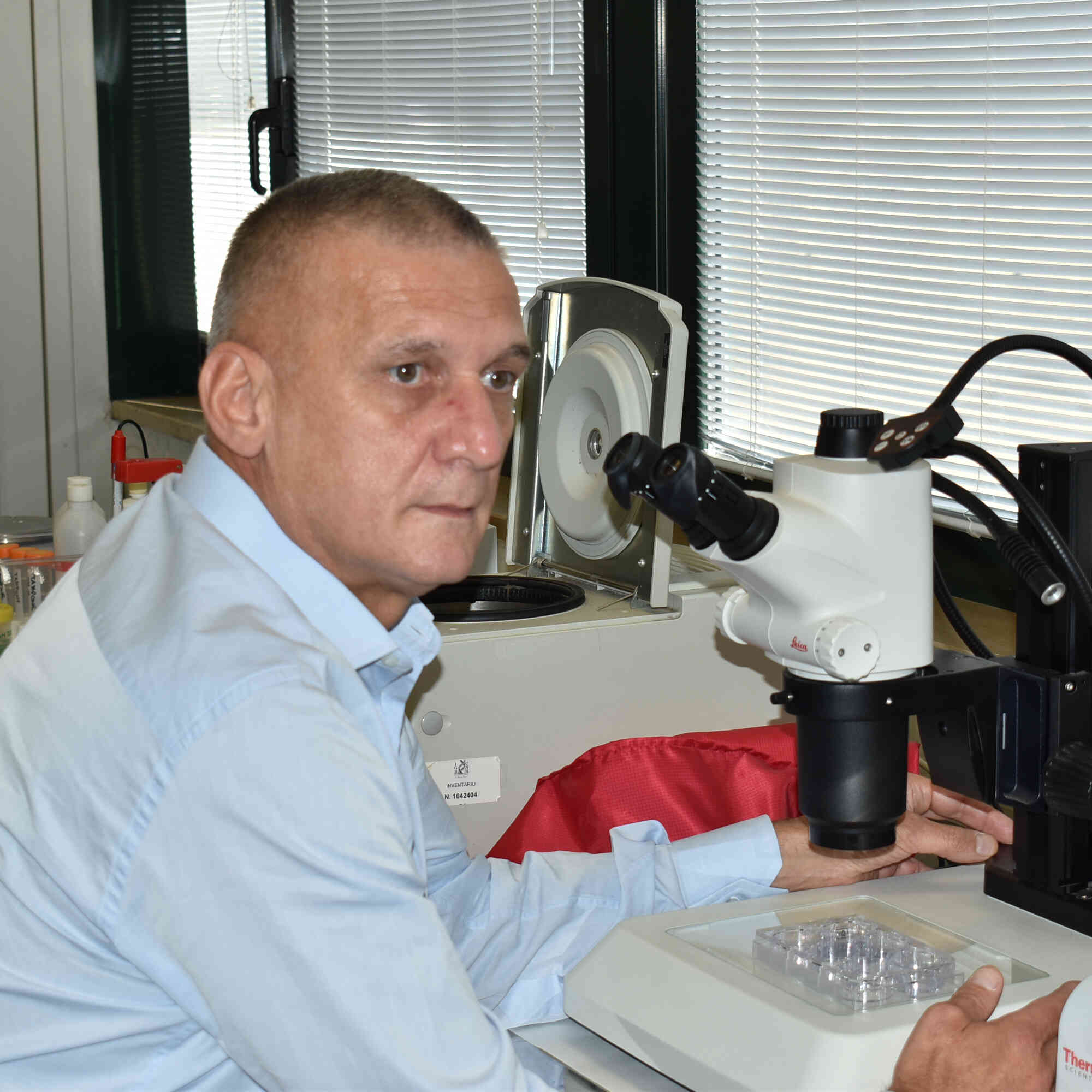- Research Interest
- Selected Publications
- Professional Experience
- Research Group
In nature, living cells are subjected to a fluctuating environment involving transient or permanent changes in physicochemical parameters such as temperature, salinity and nutrients availability. I study how cells adapt their metabolism to the environmental changes throughout their life, focusing on the interplay between metabolism and cell shape/behavior. My research interest is mainly centered on amino acids and energetic metabolism, which I have been studying over time using different cell systems ranging from bacteria to mammals:
– the dimorphic pathogenic fungus Histoplasma capsulatum that shifts its energetic metabolism during the mycelium-to-yeast morphological transition, which is induced by a temperature shift (25° to 37°C);
– the soil bacterium Rhizobium sp. that modifies its metabolism during the invasion of developing root nodules, specifically the bacteria-to-symbiosome transition that occurs when extracellular bacteria are released inside the cytoplasm of invaded plant cells;
– the pluripotent embryonic stem cells (ESCs) that modify their energetic metabolism during the embryonic stem-to-mesenchymal-like transition (esMT), which is induced by a high proline/low ascorbic acid (vitamin C) regimen.
We are currently investigating the molecular connection between proline metabolism, amino acid starvation (AAR) stress response, and the acquisition of mesenchymal features in stem and cancer cells using 2D and 3D (gastruloids, organoids) cell culture models.

Gastruloid Development Competence Discriminates Different States of Pluripotency. Cermola F, D’Aniello C, Tatè R, De Cesare D, Martinez-Arias A, Minchiotti G, Patriarca EJ. Stem Cell Reports. 2021 Feb 9;16(2):354-369.
The Multifaceted Roles of Proline in Cell Behavior. Patriarca EJ, Cermola F, D’Aniello C, Fico A, Guardiola O, De Cesare D, Minchiotti G. Front Cell Dev Biol. 2021 Aug 12;9:728576.
Proline Metabolism in Tumor.Growth and Metastatic Progression. D’Aniello C, Patriarca EJ, Phang JM, Minchiotti G. Front Oncol. 2020 May 15;10:776.
LncRNAs and PRC2: Coupled Partners in Embryonic Stem Cells. Fiorenzano A, Pascale E, Patriarca EJ, Minchiotti G, Fico A. Epigenomes. 2019 Aug 6;3(3):14.
- Metabolic-Epigenetic Axis in Pluripotent State Transitions. D’Aniello C, Cermola F, Patriarca EJ, Minchiotti G. Epigenomes. 2019 Jul 31;3(3):13.
Collagen Prolyl Hydroxylation-Dependent Metabolic Perturbation Governs Epigenetic Remodeling and Mesenchymal Transition in Pluripotent and Cancer Cells. D’Aniello C, Cermola F, Palamidessi A, Wanderlingh LG, Gagliardi M, Migliaccio A, Varrone F, Casalino L, Matarazzo MR, De Cesare D, Scita G, Patriarca EJ, Minchiotti G. Cancer Res. 2019 Jul 1;79(13):3235-3250.
- Long non-coding RNA in stem cell pluripotency and lineage commitment: functions and evolutionary conservation. Fico A, Fiorenzano A, Pascale E, Patriarca EJ, Minchiotti G. Cell Mol Life Sci. 2019 Apr;76(8):1459-1471.
- An Ultraconserved Element Containing lncRNA Preserves Transcriptional Dynamics and Maintains ESC Self-Renewal. Fiorenzano A, Pascale E, Gagliardi M, Terreri S, Papa M, Andolfi G, Galasso M, Tagliazucchi GM, Taccioli C, Patriarca EJ, Cimmino A, Matarazzo MR, Minchiotti G, Fico A. Stem Cell Reports. 2018 Mar 13;10(3):1102-1114.
- Phenotype characterization of human melanoma cells resistant to dabrafenib. Cordaro FG, De Presbiteris AL, Camerlingo R, Mozzillo N, Pirozzi G, Cavalcanti E, Manca A, Palmieri G, Cossu A, Ciliberto G, Ascierto PA, Travali S, Patriarca EJ, Caputo E. Oncol Rep. 2017 Nov;38(5):2741-2751.
Vitamin C and l-Proline Antagonistic Effects Capture Alternative States in the Pluripotency Continuum. D’Aniello C, Habibi E, Cermola F, Paris D, Russo F, Fiorenzano A, Di Napoli G, Melck DJ, Cobellis G, Angelini C, Fico A, Blelloch R, Motta A, Stunnenberg HG, De Cesare D, Patriarca EJ, Minchiotti G. Stem Cell Reports. 2017 Jan 10;8(1):1-10.
- Vitamin C in Stem Cell Biology: Impact on Extracellular Matrix Homeostasis and Epigenetics. D’Aniello C, Cermola F, Patriarca EJ, Minchiotti G. Stem Cells Int. 2017;2017:8936156.
Cripto is essential to capture mouse epiblast stem cell and human embryonic stem cell pluripotency. Fiorenzano A, Pascale E, D’Aniello C, Acampora D, Bassalert C, Russo F, Andolfi G, Biffoni M, Francescangeli F, Zeuner A, Angelini C, Chazaud C, Patriarca EJ, Fico A, Minchiotti G. Nat Commun. 2016 Sep 2;7:12589.
c-Myc modulation: a key role in melanoma drug response. Fico A, Alfano D, Valentino A, Vasta V, Cavalcanti E, Travali S, Patriarca EJ, Caputo E.Cancer Biol Ther. 2015;16(9):1375-86.
Nanoengineered surfaces for focal adhesion guidance trigger mesenchymal stem cell self-organization and tenogenesis. Iannone M, Ventre M, Formisano L, Casalino L, Patriarca EJ, Netti PA. Nano Lett. 2015 Mar 11;15(3):1517-25.
A novel autoregulatory loop between the Gcn2-Atf4 pathway and (L)-Proline [corrected] metabolism controls stem cell identity. D’Aniello C, Fico A, Casalino L, Guardiola O, Di Napoli G, Cermola F, De Cesare D, Tatè R, Cobellis G, Patriarca EJ, Minchiotti G. Cell Death Differ. 2015 Jul;22(7):1094-105.
L-Proline induces a mesenchymal-like invasive program in embryonic stem cells by remodeling H3K9 and H3K36 methylation. Comes S, Gagliardi M, Laprano N, Fico A, Cimmino A, Palamidessi A, De Cesare D, De Falco S, Angelini C, Scita G,Patriarca EJ, Matarazzo MR, Minchiotti G. Stem Cell Reports. 2013 Oct 10;1(4):307-21. (COVER PAGE)
Glutathione is required by Rhizobium etli for glutamine utilization and symbiotic effectiveness. Taté R, Cermola M, Riccio A, Diez-Roux G, Patriarca EJ. Mol Plant Microbe Interact. 2012 Mar;25(3):331-40.
- An automated high throughput screening-compatible assay to identify regulators of stem cell neural differentiation. Casalino L, Magnani D, De Falco S, Filosa S, Minchiotti G, Patriarca EJ, De Cesare D. Mol Biotechnol. 2012 Mar;50(3):171-80.
Control of embryonic stem cell metastability by L-proline catabolism. Casalino L, Comes S, Lambazzi G, De Stefano B, Filosa S, De Falco S, De Cesare D, Minchiotti G, Patriarca EJ. J Mol Cell Biol. 2011 Apr;3(2):108-22. (COVER PAGE)
Eduardo Jorge Patriarca has been trained at the Universidad Nacional de La Plata, Argentina, where he graduated in Chemistry and Biochemistry. He served as Secretary-General at the Universidad Nacional de Entre Rìos (AR) in 1986. In 1987 he changed his career path and moved to Italy with a EU granted fellowship to study the heat shock response in the dimorphic pathogenic fungus Histoplasma capsulatum at the International Institute of Genetics and Biophysics (IIGB), where he started his career as CNR Researcher in 1994. Since the very beginning he has been fascinating by how cell morphology changes in response to physicochemical cues from the local environment and how cell metabolism regulates and influences cell plasticity. Currently, he is research Director at IGB-CNR.
![]() + 390816132432
+ 390816132432 ![]() giovanna.ponticelli@igb.cnr.it
giovanna.ponticelli@igb.cnr.it
Project Title: “Generation and characterization of lung organoids for the study of Bronchopulmonary dysplasia (BPD)”


